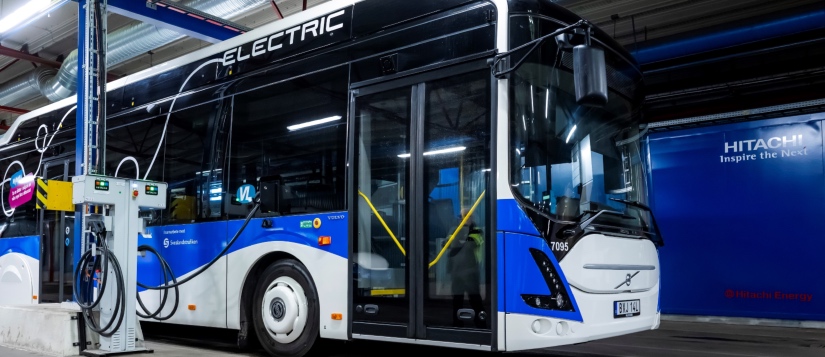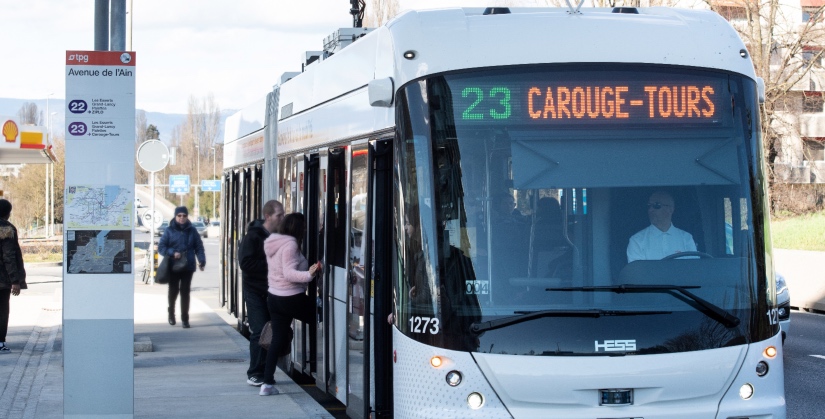By Daniel Simounet, Vice President, Transportation Industry, Americas, Hitachi Energy
Trucks and buses are the lifeblood of the transportation industry. But these same fleet vehicles that transport people and goods around the world are a significant source of carbon emissions as well as air pollution. For years, we’ve had to accept that unpalatable but necessary tradeoff.
Not any longer.
We are on the cusp of a historic shift toward the electrification of large fleet vehicles. And it’s a transition that can’t come soon enough.
Fleet vehicles, including tractor-trailers, large pickups and vans, delivery trucks, buses, and garbage trucks, move the goods we consume and provide a cost-effective and relatively energy-efficient way to get people where they need to go. While they account for fewer than 8% of vehicles on the road, trucks and buses nonetheless contribute more than 35% of direct CO2 emissions from road transport.1 On their current pace, global truck and bus emissions are forecast to double by 2050.2
But policy support for the greening of corporate fleets is spreading. Twenty-seven nations have signed a memorandum of understanding on zero emissions3 pledging to an interim goal of a 30% reduction in emissions on sales of medium-and-heavy-duty vehicles by 2030 (including buses). Separately, a nine-nation group has committed to reaching 100% zero-emission trucks and buses,4 by no later than 2035.
The pricing and operational challenges involved in switching over to electric buses and trucks are not trivial. Fleet electrification will not only require vast amounts of electricity but perhaps also new substations and other enhancements to power grids as well as facility space set aside for charging stations. However, the reality is that the dream of fleet electrification is becoming a reality.
Last year nearly 66,000 electric buses and 60,000 medium-and heavy-duty trucks hit the roads worldwide. That represented approximately 4.5% of all bus sales and 1.2% of truck sales worldwide,5 according to the International Energy Agency (IEA). While the numbers might seem modest at first glance, global sales of both electric buses and electric medium-and heavy-duty trucks are growing at double-digit rates.
The numbers reflect the steady advances in battery technology over the last couple of decades, allowing for higher densities that store vastly more energy in smaller packages. That has helped extend driving ranges to meet fleet operational needs of zero-emission buses and medium-duty trucks operating on a single charge. At the same time lithium-ion batteries are becoming available for much cheaper prices due to continued drop in production costs as they are used in large volume applications such as laptops, phones, cars, and others. These intersecting trends have now made truck and bus fleets ripe targets for decarbonization.

The bus industry has a clear incentive to accelerate its deployment of e-bus networks. While buses are lauded as an environmentally friendly transport mode, diesel engines generate large amounts of nitric oxide, nitrogen dioxide, and particulate matter. (Particulate matter exposure has been directly linked to causing various health problems in humans.6) Eliminating emissions not only reduces a critical greenhouse gas, it also improves air quality, a particularly important concern in urban areas where buses and small- and medium-sized trucks are especially active.
While sustainability is clearly in a fleet operator’s enlightened self-interest, the case for electrification reflects good business sense, too. In addition to the environmental benefits, there are myriad economic gains from fleet electrification including significant cost-savings in both fuel and maintenance, improved brand reputation, vehicle-to-grid opportunities, government incentives, and job growth.
Municipalities switching to electric buses also reap operational advantages. An e-bus may initially cost more than a diesel bus because of the battery costs. But after factoring in the total cost of ownership over its expected 16-year lifetime, e-buses turn out to be cheaper than diesel buses. They are simpler to maintain – mechanics don't need to change filters or deal with any of the many moving parts found in vehicles powered by complex internal combustion engines. The simplification of the power train to an electric motor, a drive, and a battery eliminates a lot of problems and labor.

As fleet operators embark on what will be a complicated journey, they are leaning on Hitachi’s experience to navigate this transition. As a leading global company and a pioneer in transportation solutions for more than a century, Hitachi is supplying the infrastructure that partners and customers are using to transform their operations to achieve a carbon-neutral future. For example, Hitachi Energy Canada Inc. is providing a grid-to-plug solution for an electric bus trial project being conducted by the Réseau de transport de la Capitale (RTC), an urban public transit provider in the greater Quebec City area.
Quebec’s government plans to electrify 55% of its urban buses and 65% of its school buses by 2030,7 an important goal in a nation where transportation accounts for 25% of total greenhouse gas emissions.8 The three-year test, which began at the end of 2022, constitutes an important step towards the ultimate electrification of the RTC’s entire bus fleet and the reduction of CO2 emissions in the province. It features Hitachi Energy's Grid-eMotion® Fleet, a grid-to-plug solution that’s been deployed in sustainable transport projects at some of the biggest urban bus systems in the world including London and Berlin.
The outcome of the Quebec pilot will provide important learnings for the deployment of electrification infrastructure in existing urban garages. Already cramped, these aging spaces don’t have much room for traditional individual chargers to deliver the megawatts needed to supply fleets with electric power. But Grid-eMotion® Fleet is an integrated charging system starting at 1 megawatt power which can be expanded to multi-megawatt system with the capability to be connected to a medium voltage grid connection. This technology allows a 60 percent reduction in space required for large-scale EV fleet charging and a 40 percent decrease in the amount of depot cabling required.
This is just the start. Fleets understand that electrification projects are going to be central to any efforts to reduce greenhouse gas emissions. Now that technology is available to help them reach that objective, it helps to have a technology partner ready to be by their side every step of the way.
Hitachi can help

Vice President, Transportation Industry, Americas, Hitachi Energy
Daniel has led the transportation industry segment for Hitachi Energy in the Americas region since 2011. He has more than 25 years of experience in the rail and transit industry in roles spanning engineering, marketing, sales, product management and business development. He has extensive experience working with a variety of associations, technical committees and NGOs in the electrical and transportation industry and is a recognized expert in the field of the electrification of transport and sustainable mobility. He currently serves as a board member of InnovÉÉ and IVI Solutions and holds an advanced technical diploma in electrical engineering from the School of Gustave Eiffel in Bordeaux, France and an Executive MBA from the University of Québec in Montreal.